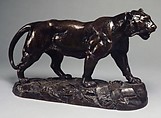Walking Tiger (Un tigre qui marche)
Antoine-Louis Barye French
Not on view
While the primal energy of the animal world was one of the favorite subjects of French artists of the Romantic period, the meticulous observation of nature evident in Barye’s animal sculpture owed much to advances in the study of the natural sciences made during the eighteenth century. Toward the end of the century, a cabinet of comparative anatomy was established at the Muséum d’histoire naturelle in Paris. Barye pursued his animal studies there, as well as among the live animals in the menagerie of the Jardin des Plantes, where he went to sketch and model from life, sometimes in the company of his friend Delacroix.
Barye’s animals, however, are never merely scientific illustrations. Beyond their surface realism, there is an unerring sense of the inner structure based on thorough knowledge of animal anatomy. This is evident in the detailed drawings of bone and sinew and in the moveable skeletal models that he constructed and used in aids to composition. Rodin, who in the 1860s studied briefly and informally with Barye, later observed that Barye’s working method was from the inside out. “I model from the bone up,” Barye told him. Above all, there is the vividness of life in the smallest of Barye’s sculptures.
Due to rights restrictions, this image cannot be enlarged, viewed at full screen, or downloaded.

